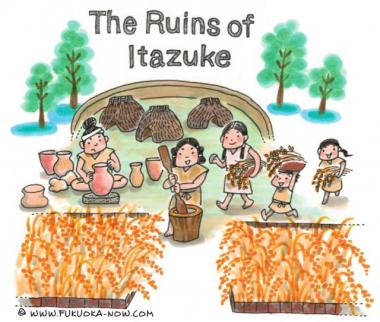Hakata Culture vol.102
Learn about the Beginning of Rice Cultivation at the Itazuke Ruins

Not far from the airport, in the middle of a residential neighborhood in Hakata Ward, sits a small park-like facility. Surrounded by greenery, what looks like a regular park at first glance is actually the Itazuke Ruins―a national historic site where you can learn about the history of Japanese rice culture. A full-scale excavation of the area began in 1950 after Jomon and Yayoi-style pottery were unearthed here.
Surrounded by double V-shaped moats, the site of the Itazuke Ruins is one of Japan's oldest moat-enclosed villages. Excavations revealed various kinds of pottery and stone tools as well as nearby holes for storing rice. Archaeologists also found a graveyard for people who may have been influential in the village. There are ruins of rice paddies near the village, and the existence of dykes and irrigation channels for diverting water from a nearby river and suggest that the rice cultivation technology of the time was rather advanced.
If you go to the Itazuke Ruins today, you can see recreations of a Yayoi era village and rice paddies, but excavations have revealed even older Jomon era remains beneath them. In other words, the Itazuke Ruins are composite remains spanning multiple time periods. Rice cultivation in Japan is thought to have started in the late Jomon period, and the trace evidence at the Itazuke Ruins make it one of the earliest―if not the earliest―settlements in Japan that cultivated rice.
Today, the site is home to the Itazuke Ruins Park. Items excavated from the site and displays on ancient ways of life are housed in the Itazuke Ruins Yayoi-kan Museum. In the spring and fall, "village festivals" are held to plant and harvest the paddies using old techniques. The Itazuke Ruins offer a rich learning experience, so if your children have to write school reports this summer, why not take them there?
板付遺跡で学ぶ稲作の始まり
福岡市博多区の団地やマンションが立ち並ぶ住宅街に、緑に囲まれた公園のような施設があります。一見、普通の公園のようですが、実はここ、日本の稲作文化について知ることができる貴重な遺跡、国の史跡に指定された板付遺跡です。昭和25(1950)年に、縄文式土器と弥生式土器が一緒に出土したことから本格的な発掘が始まりました。
板付遺跡は日本で最も古い環濠集落(周囲に堀をめぐらせた集落のこと)のひとつで、V字型の二重環濠に囲まれています。さまざまな土器や石器などが出土し、集落の近くには米などを保存する貯蔵穴群や、有力者を葬ったとみられる墓地も発見されています。また周辺には整備された水田の跡もあり、近くの川から用水路を引き込んだり、水路の途中には井堰を設けたりするなど、当時の高度な土木技術の様子もわかっています。
板付遺跡で見ることができるのは弥生時代の遺跡を復元したものですが、さらにその下には縄文時代の遺跡が残されていることがわかっています。つまり板付遺跡は複数の時代にまたがる複合遺跡なのです。縄文時代晩期には稲作が始まっていたことを裏付ける痕跡も残されており、板付遺跡は日本で最も早い稲作文化を伝える遺跡のひとつです。
現在の板付遺跡は「板付遺跡公園」として整備され、弥生時代の集落や水田の様子などが再現されています。さらに出土品や古代の生活の様子を展示した「板付遺跡弥生館」があり、遺跡について多くのことが学べます。敷地内の水田では春と秋に「ムラ祭り」を行い、昔ながらの方法で田植えや稲の収穫をしています。子どもたちの夏休みの自由研究にもぴったりなので、一度訪れてみると楽しいかもしれません。

